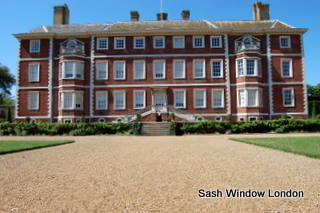A cornerstone of our architectural heritage, the sash window has added elegance and style to buildings for centuries. The history of sash window dates as far back as the 1600's, there is a character to sash windows that goes beyond functionality and design, whenever these windows are used, on-lookers will automatically describe the home as "Classy, Victorian or Georgian".
Comprising two vertically sliding glazed sashes supported by weighted cords, the origins of the box sash window are the subject of much speculation. Some attribute their design to the scientist and inventor Robert Hooke, others say the style developed from the 'Yorkshire Sash', which slides horizontally and without weights.


Regardless of its beginnings, by the end of the 17th century, the sash window was wildly popular and coveted by the aristocracy, appearing in palaces such as Hampton Court and Kensington, as well as other prominent buildings, such as Chatsworth House and Ham House. Wooden sash windows soon became the fashion du jour, and the trend swept across Britain, their popularity flourishing until the 20th century, partly due to their practicality - they closed to a narrower gap than the hinged variety, which helped keep out the rain and made them less susceptible to rot - but also due to their aesthetic appeal.
It was no surprise that the pioneers of Georgian architecture later fully embraced the sash movement, even adding to the design by changing the fixed top to the more modern two moveable sashes. Glass manufacture gradually improved and panes became larger in size, with the Georgian style of six by six panes becoming popular.
The Victorians took the design of the box sash window further, focussing heavily on elaborate details, incorporating decorative features such as horns, latticework and mouldings into the structures.
By the turn of the century, the sash was the most widely used window, but since the first world war, its popularity declined, possibly due to the high labour costs involved in its manufacture when compared to cheap, mass produced varieties.
Sash windows have continued to be developed, and are currently experiencing a resurgence, as people once again value the aesthetic appeal and high quality craftsmanship integral to their design.
The design of sash windows is very traditional and in a sense, it's a part of England's heritage. We should be proud of using sash windows for our homes. It is rather sad to see that many modern folks who inherit homes from their parents or relatives decide to replace the original sash windows with contemporary ones. One of the reasons given is that the 'window wood was rotting' or that the sash windows were 'beyond repair'. Some homeowners decide to replace them with modern replicas, which are often neither here nor there.
Beyond repair? In most cases that could not be further from the truth.
It does not matter whether the sash windows in your house are glazed panels that slide vertically or horizontally. The sash windows in your home can normally always be repaired. The key is in hiring the right people to do the job. If it can be restored, why replace it with replicas? This is England's and your family's heritage and there's a history in these windows. Even in these modern times we should treasure the heritage that our long-gone relatives have left behind for us to embrace.
Beyond the cosmetic value, there is a historical value to the windows that is meant to be cherished over many generations. New owners of homes that come with original sash windows should exhaust all efforts to repair the original windows instead of replacing them with modern replicas. There are many benefits to that reasoning and on top of that the woodwork and the way they are installed can meet many specifications governing older listed or graded buildings and homes where modern windows are prohibited.
